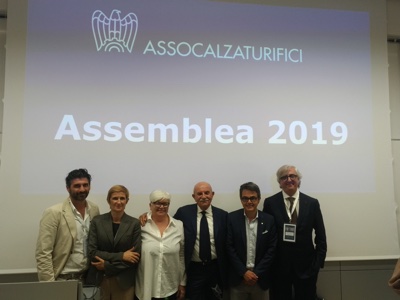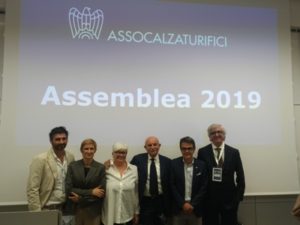
On the occasion of the Confindustria Moda conference, Assocalzaturifici held its general assembly with the election of the new board of directors, with Annarita Pilotti standing down and Siro Badon taking over in the role of President. At the same time, there was the nomination of Vice Presidents Federico Bartoli from Tiger Flex, Salina Ferretti from Falc, Giovanna Ceolini from Thierry Rabotin, Gianpietro Melchiorri from Gal.Men and Pasquale Della Pia from Dei Mille. Plus, Andrea Brotini from Pakerson was nominated as arbitrator.
Below are Annarita Pilotti’s final words as President, the exclusive interview with Siro Badon, the current economic scenario of the sector, and a study on the generational changeover in sector companies.
Annarita Pilotti: the “pasionaria” of footwear looks back on her term of office
With the same passion with which she headed the association over the last four years, Annarita Pilotti, the first 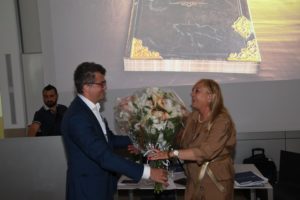 woman to ever serve as the President of Assocalzaturifici, wanted to say goodbye to her fellow footwear manufacturers by recalling the highlights of her tenure. Among her successes she mentioned “The renewal of Micam, the new dates and its restyling; the spending review policy; the renewal of the national labour agreement; the approval of redundancy funds for the sector; the exemption from tax of samples; the creation of a fashion table and her role in launching Confindustria Moda, the new headquarters of the association and those of Cimac; and the establishment of a desk for lobbying activities in Brussels”. At the same time, she does have some regrets concerning her inability to obtain “the ‘Made In’ label and to cease economic sanctions against Russia”.
woman to ever serve as the President of Assocalzaturifici, wanted to say goodbye to her fellow footwear manufacturers by recalling the highlights of her tenure. Among her successes she mentioned “The renewal of Micam, the new dates and its restyling; the spending review policy; the renewal of the national labour agreement; the approval of redundancy funds for the sector; the exemption from tax of samples; the creation of a fashion table and her role in launching Confindustria Moda, the new headquarters of the association and those of Cimac; and the establishment of a desk for lobbying activities in Brussels”. At the same time, she does have some regrets concerning her inability to obtain “the ‘Made In’ label and to cease economic sanctions against Russia”.
Siro Badon: going beyond fairs, an association at the service of entrepreneurs
Siro Badon, at a distance of thirty-five years from the tenure of Luigino Rossi, brings back to Riviera del Brenta the presidency of Asocalzaturifici. So, who exactly is the new President? Originally from Padua, in 1975, he became part of the Calzaturificio De Robert di Saonara shoe company owned by his family, an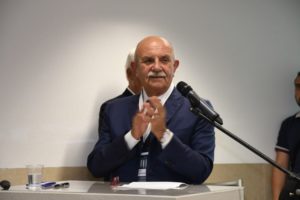 d over the years, he has covered various roles, from production and administration management, to sales, while opening the company up to markets like Northern Europe and Asia. An activity for which he was recognised in 2010, with the granting of the “Marco Polo” award by the Unioncamere Veneto. His professional life has always been flanked by his corporative one, which has seen him sit in on the Board of Directors of Confindustria Venezia Rovigo, of NeaFidi, Confindustria Padova, Confindustria Veneto, Politecnico Calzaturiero, and act as Assocalzaturifici Vice President in charge of education and professional training. For the last eight years, he has also covered the role of President in ACRIB, the Association of Riviera del Brenta Footwear Manufacturers.
d over the years, he has covered various roles, from production and administration management, to sales, while opening the company up to markets like Northern Europe and Asia. An activity for which he was recognised in 2010, with the granting of the “Marco Polo” award by the Unioncamere Veneto. His professional life has always been flanked by his corporative one, which has seen him sit in on the Board of Directors of Confindustria Venezia Rovigo, of NeaFidi, Confindustria Padova, Confindustria Veneto, Politecnico Calzaturiero, and act as Assocalzaturifici Vice President in charge of education and professional training. For the last eight years, he has also covered the role of President in ACRIB, the Association of Riviera del Brenta Footwear Manufacturers.
The presidency returns to Riviera del Brenta with your nomination. What significance does this have for your district?
“For a start, it is a great satisfaction and a confirmation that today ACRIB is one of the most renowned territories on the productive panorama of Italian footwear”.
What will be the priorities on which your term of office will focus?
“In my opinion, the Association must be seen a little differently from the way it’s been seen up until now. It is much more than a simple organiser of trade fairs. It must start speaking of eco-sustainability, it must begin to speak of training but of a higher level, it must also become a structure of services, because today our entrepreneurs have a need to go out into the world, but with completely different prerogatives. Naturally, entrepreneurs must also give themselves a big helping hand. Because the association does not have a magic wand and is not omnipotent. What we can do is orient businesses, provide advice, and support the activities of entrepreneurs by signing agreements and lobbying”.
The collaboration with Confindustria Moda will of course continue…
“We are by now a ring in the chain of Confindustria Moda. Working together, each one takes advantage of what the other one has and vice versa”.
How will you handle the ‘Made in’ issue?
“We must continue to fight this battle that has now been underway for the last fifteen years. ‘Made in’ is a matter of identifying the product: we know very well that politically speaking we have problems, and this is a fact. Nevertheless, we will do our best to move forward with this issue, by maybe finding an alternative for the specialisation of the Italian product. And we will continue to lobby on various institutional, national and European issues”.
The future of Micam?
“It is the most important international fair worldwide, it was in the past and it will also be so in the future. There could be eventual investments by the associations aimed at improving its look and raising it up as high as possible. And we have a lot of ideas in this regard. First and foremost, we would set up a Technical-Scientific Committee made up by Representatives of Confindustria Moda, experts in the world of fashion, influencers, sociologists, analysts of consumer trends and exhibitors, which would interact and discuss with the presidency to make the participation of businesses and buyers in the event increasingly extensive and strategic”.
And on international markets?
“Policies of internationalisation will be supported and reinforced, in collaboration with ICE, through promotional and business missions, scouting on markets and targeted programs for incoming delegations to introduce the assets of our footwear manufacturers to international clientele including its history, tradition, know-how, and above all its ability to faithfully present the Italian lifestyle”.
An overview of the footwear manufacturing industry: a less than exciting beginning to 2019
After a 2018 that was not exactly positive, with slowdowns recorded in production (-3.3%) and in exports (-3.7%), but with a positive trend in values, in 2019, the footwear manufacturing industry got off to a new negative start. During the first quarter of 2019, a new drop in production was recorded (-2.6%), with values holding steady (+0.3%), and a slowdown in exports to the EU and non-EU areas, with values on the rise however: a sign of the excellence of the Italian product, but also of the bearing of leading international luxury brands. Among the destinations in the EU, France experienced a recovery (+16% in volume and +12% in value), while there were drop-offs in Germany (-10% in quantity and -3.2% in value), Belgium, and the Netherlands. Following an uptrend were instead the United Kingdom (+8.5% in quantity) and Spain (+4.1%).
Outside of the EU, the situation was further aggravated in the CIS area, with Russia down by -21.3% in quantity, the Ukraine at -4.1%, and Kazakhstan recording an astounding -30%. There were instead new positive trends in Switzerland, which recorded +11% in quantity and +23% in value: figures that are connected to its designer label subcontracting activities.
The Middle East instead followed a negative trend (United Arab Emirates at -6% in volume), while the Far East grew by +10.3% in value, with a slight drop-off in pairs (-1.3%). Values in the leading markets grew with performances estimated at around +10% (except for Japan with its +5.6%): China (but with a drop in quantity equal to -4.1%), Hong Kong, South Korea, and Japan (with -10% in quantity). The same trend with values on the rise (+14.4%) and volumes down (-3.4%) was recorded in North America.
Among the biggest problems in the sector is the domestic market with its persisting negative trend, which was further complicated by a winter season that was relatively mild and which led to a drop in quantities (-2.3%) and in purchases (-3.8%).
How do the businesses involved intend to react to this situation? The study undertaken by Assocalzaturifici highlights a use of the following instruments as a possible solution: an optimisation of costs, the development of new products and new markets, the study of new strategies of distribution and investments in promotional activities.
The new generations of footwear manufacturers
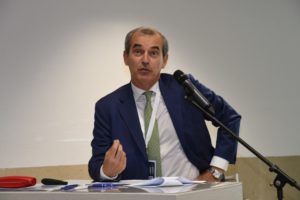
The excellences of the footwear-manufacturing segment caught between the two opposing forces of a drive towards innovation and the preservation of craftsmanship during the critical moment represented by the generational turnover, ended up under the magnifying glass of a study commissioned by Assocalzaturifici and presented during the National Assembly: “Family-owned footwear manufacturing businesses. Stories of a generation that innovates”. The editors are Valentina Lazzarotti, associate professor at the Scuola di Ingegneria Industriale [School of Industrial Engineering] and Federico Visconti, dean of the LIUC Università Cattaneo.
By analysing 11 case histories of businesses par excellence in the sector, the study illustrates the existence of “a footwear manufacturing pathway of innovation – explains Federico Visconti – the fundamental ingredients of which can be found in the ways with which key innovative processes are activated, with the systematic opening up to contributions by third-party players, in the tendency to connect specific actions with the results achieved, and in the pursuit of a new balance between the interests of the family that owns the business and the business’s goals for development”.

